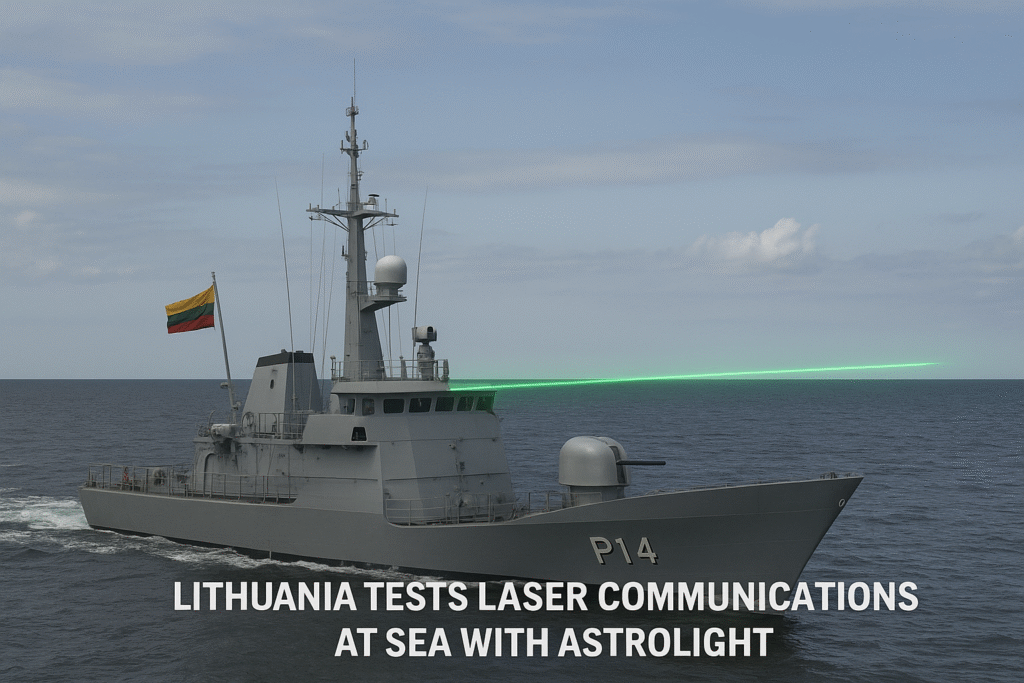
A Breakthrough in Maritime Communication
Lithuania has marked a major technological milestone by successfully testing laser-based communication at sea, in collaboration with local startup Astrolight. This test, which took place aboard the Lithuanian Navy’s patrol ship Aukštaitis (P14), is among the first real-world demonstrations of laser communication (or optical communication) over maritime environments — and it’s generating significant buzz in defense, aerospace, and tech circles.
Why Laser Communication?
Traditional radio-frequency (RF) systems face limitations in speed, bandwidth, and susceptibility to interference or jamming. Laser communication, on the other hand, offers:
- 📡 Data transfer speeds up to 100 Gbps
- 🔐 Higher security through narrow-beam transmissions
- 🚫 Reduced susceptibility to electromagnetic interference
- 🌍 Applications across sea, air, and space platforms
This technology, previously tested mainly in satellite-to-satellite or satellite-to-ground setups, is now being explored in naval and terrestrial domains — offering potential to revolutionize how governments, militaries, and industries exchange critical data.
The Astrolight System in Action
Astrolight’s prototype is capable of establishing line-of-sight laser links between moving platforms — such as ships or drones — and satellites or other stations. During the Lithuanian Navy test, the company demonstrated the system’s ability to maintain a stable and high-speed optical link, even in dynamic sea conditions.
“This is a world-class innovation that showcases Lithuania’s potential in advanced technology and defense innovation,” said Tomas Šernas, Lithuanian Ministry of National Defence official.
The system’s hardware includes:
- An advanced optical terminal mounted on the ship
- Real-time tracking and alignment software
- Encrypted laser signal module for secure data transfer
Strategic Implications for Defense and Industry
The success of this test signals a strategic shift in how nations like Lithuania are preparing for modern threats and digital warfare. High-speed optical communication allows for:
- Real-time coordination of naval fleets or UAVs
- Faster and safer data exfiltration in espionage or intelligence missions
- More reliable communication in hostile RF environments
Beyond military applications, laser communication systems could benefit:
- Offshore wind farms
- Cargo and logistics vessels
- Remote marine research stations
- Emergency response in oceanic disasters
About Astrolight: A Baltic Tech Star
Astrolight is a Lithuanian aerospace tech company specializing in space and defense communication systems. The company aims to bridge the gap between Earth and orbit through optical laser links, with potential use in:
- LEO satellite constellations
- Drone-to-satellite networks
- Deep-space missions
Founded in 2019, Astrolight has received backing from the EU, Lithuanian government bodies, and multiple innovation grants.
What’s Next for Lithuania and Laser Comms?
Following this successful maritime test, Lithuania plans to further invest in:
- Satellite-to-drone laser link trials
- Integration with NATO digital communication frameworks
- Joint ventures with other Baltic and Nordic nations
This initiative also aligns with Lithuania’s broader strategy to position itself as a leader in European defense innovation, especially in areas like cybersecurity, drone warfare, and encrypted communications.
Conclusion: Lighting the Future with Lasers
Lithuania and Astrolight have taken a bold step toward next-generation data transfer technology — and the sea is just the beginning. As laser communication continues to mature, expect to see it extend from naval platforms to satellites, drones, and even urban networks.





